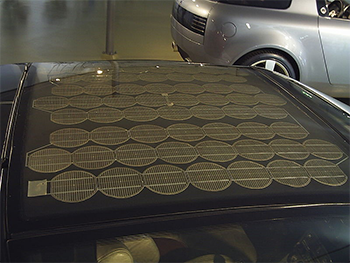InTrans / Nov 17, 2014
Cars now and into the future
Go! Magazine
 posted on November 17, 2014
posted on November 17, 2014
By the year 2050, it is projected that most cars will not involve a human driver. Technology that replaces the human driver would avoid crashes caused by human error, which makes up nearly 95 percent of all accidents.
Wouldn’t it be cool to have a car that deployed airbags from under your car? This technology is being tested for crashes where impact is inevitable. I imagine that would feel really weird to have an airbag almost lift your car off the ground. The crazy part is that this would happen before you even crash!
Also, if you have ever used cruise control on your car, you know how nice it is to give your foot a break from pressing the pedal. Now there is a technology where your car detects the speed of the cars around you and changes your cruise control speed accordingly. That means no more breaking suddenly and having to reset your speed. What about seeing pedestrians late at night? Have you ever had a close call where you were driving and did not notice the pedestrian crossing? Soon they will have cars that detect pedestrians and automatically slow your car down for you. This could be an important technology to help cut down the amount of pedestrian/motor accidents, which accounted for 76,000 pedestrian injuries in 2012 alone.
All of these safety features are very cutting edge and will likely make it into the car manufacturing market to increase driver safety. Driver safety and crash test ratings are very important to car consumers. Another consideration for consumers is the cost of owning and operating the car. For example, cars that have low gas mileage are very expensive to drive, which makes them less popular today.
What about the energy to power a car?
I wonder, though, with more cars on the road and the risk to driving being less, how many more cars will be on the road for longer. Having improved gas mileage is a plus, but may not be enough.
The fact that 50 percent of cars are predicted to be of hybrid technology could mean that consumers are interested in the costs and/or environmental impacts associated with running cars today.
A car that could run without any extra cost
Most all cars on the road around the world are fueled by either gasoline, compressed natural gas, or diesel. There is one important issue with this fact: all these energy sources are nonrenewable, which means they will eventually be depleted and run out. They also contribute to greenhouse gas emissions, which as you may know, leads to several negative environmental impacts. These include a changing climate, increased ocean acidification from excess CO2, and melting polar ice caps (to name a few). So what if we could have cars that run on renewable energy? Currently, there is a technology that puts energy-storing body panels on cars to help make this possible. The technology to store energy in the panels would also have the ability to capture sunlight energy, like in Figure 1, and be stored for later use.

The energy storing body panel was first introduced in Europe by nine different manufacturers. The technology has been led by the car manufacturer, Volvo. Also, these panels could reduce the car’s weight by 15 percent due to the type of material used instead of what is currently being used. They have made these body panels with strong and lightweight materials like in Figure 2.

This is a positive, because less weight means less energy required to drive. Imagine a car with solar panels on the surface of the car and energy storage on the sides. And what if it could recapture the energy from the wind, or even water, during travel and then stored in the panels for later use? In other words, the panel of your car starting from the back and leading to the first back door would be like one long battery for your car. Figure 3 shows an example of a wind capturing technology (a windmill). The car would use some of this energy for driving, but also store additional energy when the windmill is spinning and the car is not in motion.

You are the future
Ultimately, the type of cars produced are the ones that are of highest demand. So, as a potential future consumer, what type of technology will you consider to be important? I can bet that at least one—safety, environmental benefits, and cost—will be part of your consideration.
Related links
http://auto.howstuffworks.com/fuel-efficiency/vehicles/solar-cars.htm
http://auto.howstuffworks.com/under-the-hood/trends-innovations/5-future-car-technologies.htm#page=5
By Jackie Nester, Go! Staff Writer